
Monday, July 31, 2000
Orford Bay to Francis Bay
|
South Down the
Butte Inlet
I
knew the wind would be in our favor early. So I woke at 5 am and sailed off anchor. I
barely moved faster than the current. At one point, there was an entire tree floating next
to me—roots and all. 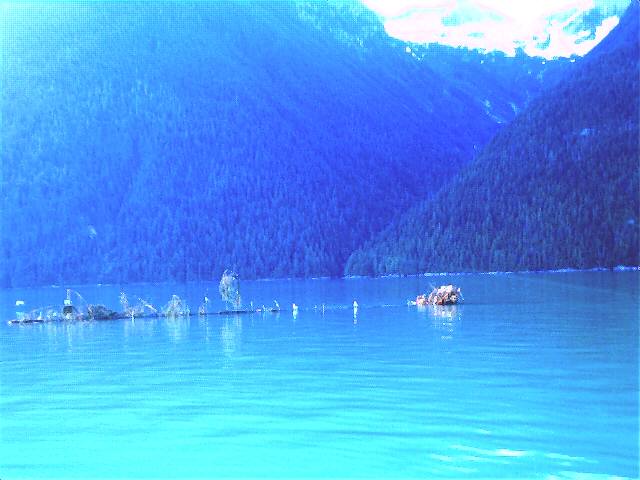
There
was a bird on it and it seemed they were making better way than we were. So, I doused the
jib and set the genoa. Soon we were up to 5 knots and the wind was rising. I doused the
mainsail and continued with only the genie to 6 knots.
Deb woke and made breakfast.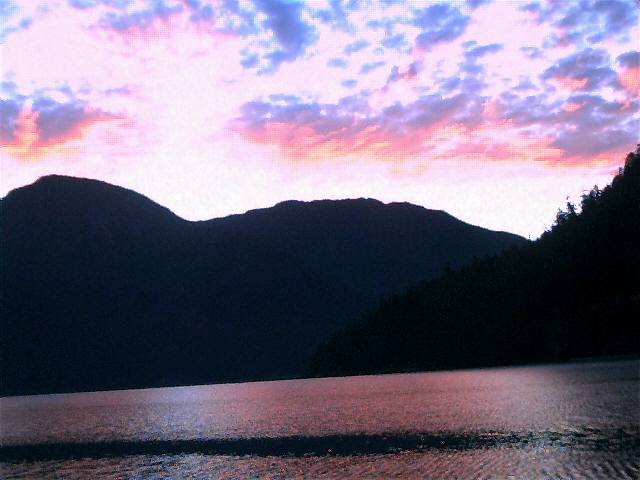 Since I
hadn’t started the motor, she thought we were still anchored. We were half way back
down the inlet. I was tempted to continue to the head to see the giant snow fields, but I
felt lucky to have the good weather and didn’t want to push it in such a remote,
unprotected place. Since I
hadn’t started the motor, she thought we were still anchored. We were half way back
down the inlet. I was tempted to continue to the head to see the giant snow fields, but I
felt lucky to have the good weather and didn’t want to push it in such a remote,
unprotected place.
That was a good decision.
Some dark clouds began to approach from the
west and the wind picked up even more. We were healing over and sailing hard. The storms
were small and I was able to move out of their way. By late afternoon, I realized that
they were forming a squall and there was no way to avoid being in it. We dropped the sail
and even though the sun was still shining on us I told Deb to put on her foul weather
gear. We began motoring toward the protection of Francis Bay.
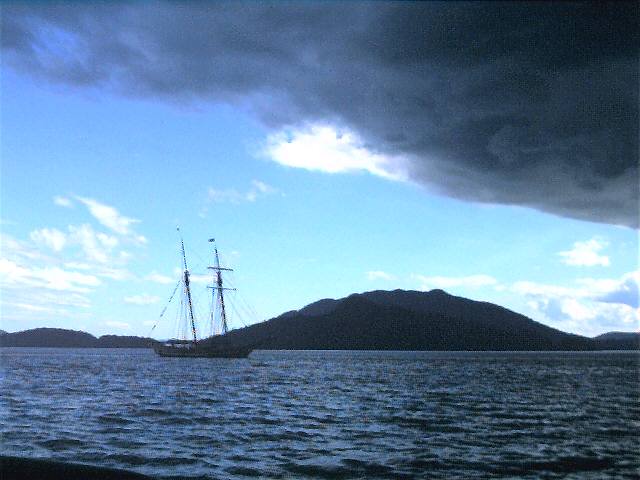
A huge schooner passes as the clouds quickly surrounded us.
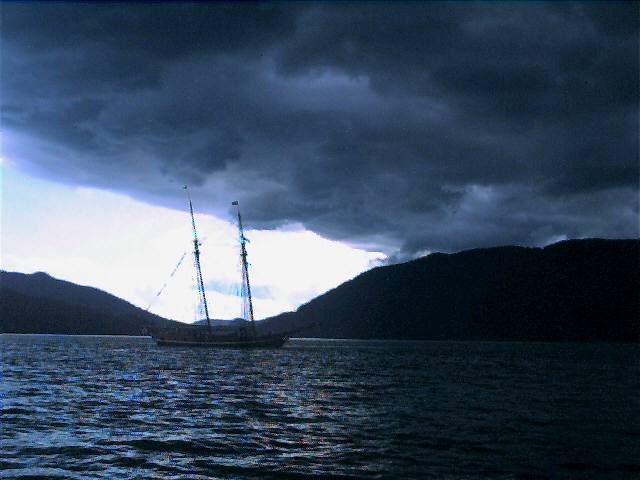
First there were a few drops…then thunder. I turned off all the electronics and sped
up. Soon we were in a complete storm. The wind and waves rose and smacked us around from
all directions. Then the rain dumped so hard I could no longer see the shore. We fought
the wind and rain into Francis Bay.
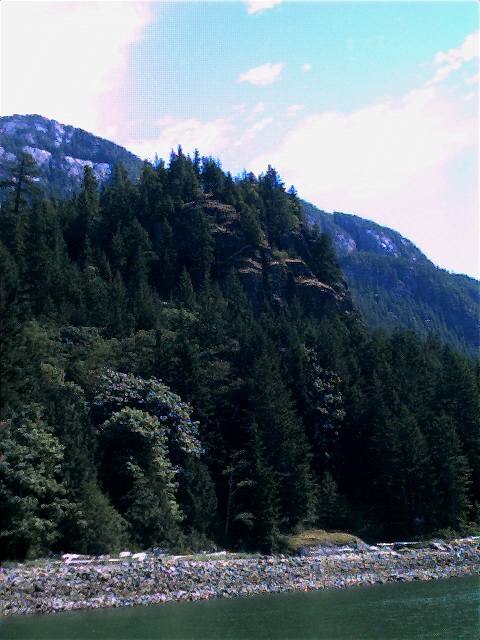
By the time we arrived at the shallow head
of the bay, the sun was out and mist was rising from the forests surrounding us.
We were safe and sound once again. I prepared to toss the anchor as Deb
steered us into the wind. But a guy from another sailboat already anchored started
shouting at us. I put down the anchor and
listened.
He said something about that being a bad
spot and I should got over to where the other boat was and it would be better because of
the wind direction. More advice…
Now do I totally defy this guy or take his advise
and move to a different spot? Well at that time I was not totally convinced (as I am now)
that most of the people out there don’t know what they are doing. And very few
actually know more than I do. In fact, all of the people I know that are excellent sailors
are in the
South Pacific or something and not up here setting an anchor in Francis Bay.
But I lack confidence, especially
when
I
have the eyes of
five
other sailors looking at me
through binoculars from their boats. So I moved to the recommended spot. I tossed the
anchor and had Deb reverse hard to set it. We had the routine down. It dragged a bit, then
caught hard. Then there
I
was far enough from the guy with the advice but about 20 feet
away from this other guy. So I raised the anchor and tried again. By the time the anchor
caught, I was about 50 feet from a small sailboat. I waited and it seemed fine so we made
dinner and prepared for bed. At about 9
that night the wind shifted and all of the boats
swung around their anchors. I went outside to check on things when the guy next to me
said, "You’re dragging your anchor." I don’t think I was, but I could
be wrong. So after an hour or so of watching the wind and the boats react I realized that
I had more scope than the boat closest to me. Scope is the ratio of anchor line versus the
depth of water. We were in 30 feet of water so I had 90 feet of line out for a scope of 3
to 1.
Scope is the single most important thing to consider when anchoring. An anchor that
stays horizontal stays put. But if the anchor is being tugged upward, it will drag. (I
spent the last couple of days reading several of my books on anchoring after the previous
mishaps). However, when you have more scope then other anchored boats in close
proximately, then you run the risk of swinging into them. So at about 11pm, I decided to
set a stern anchor. I let our the bow anchor line, waited for the boat to swing away from
the other boat, then tossed the stern anchor. I pulled the bow anchor to back to a scope
of 3 to 1 and hoped the stern line was set. There was really no way of knowing. I went
below but I couldn’t fall asleep. I eventually went out on deck and fell asleep in
the cockpit to make sure we were all okay. Of coarse we were fine.
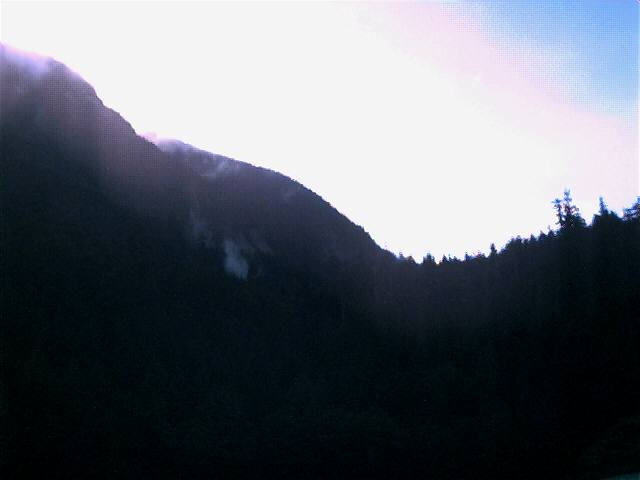
I learned an important lesson that long cold night. When I am confident that I know what I
am doing, I will trust my own
judgment
more from now on.
Frank

|